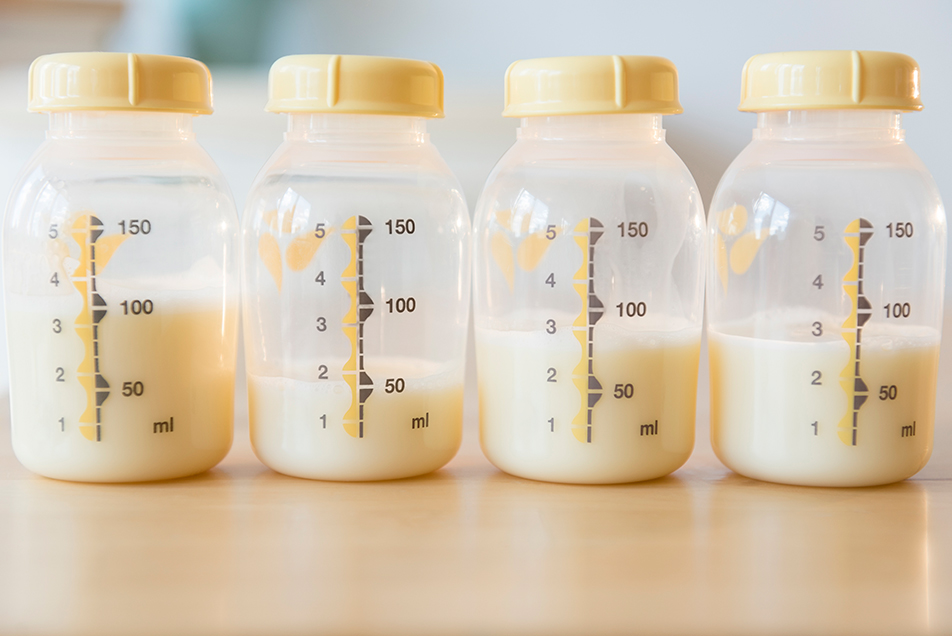
When a little one arrives, a woman’s body is designed to supply the ideal nourishment. Jeanne Buta, RN, IBCLC, and Danielle Wisniewski, RN, IBCLC, explain how this works and how it supports baby’s development.
What is colostrum?
Colostrum is the first stage of breast milk. It develops during pregnancy and lasts for several days after birth. Colostrum is yellow and thick in consistency or can appear clear and runny. Babies need small amounts of food, and the mother’s colostrum is perfect in components and volume.
What’s in colostrum?
According to the book, “Counseling the Nursing Mother A Lactation Consultant’s Guide, 5th edition” by Judith Lauwers and Anna Swisher, colostrum consists of residual materials in the breast that mix with newly formed milk. It’s richer than mature milk in terms of its sodium, potassium, chloride, protein, fat-soluble vitamins, and minerals content. Colostrum engulfs and digests disease organisms and aids in rapid gut closure.
It contains:
- Fat – Low amount for easy digestion (also lower in lactose than mature milk)
- Antibodies leukocytes, IgA, IgG, IgM – Protects baby against disease (these are high in concentrations)
- Protein – High in protein, which supplies rapid growth
- Lactoferrin – Protects baby from infection, is anti-inflammatory and aids with iron absorption
Transitional milk
Around day 3 to 5, transitional milk replaces colostrum. This creamy milk has increased levels of lactose and fat for energy and growing.
Mature milk
Sometime after transitional, usually around 2 weeks, mothers mature milk supply will come in. This milk often appears thinner and may have a bluish tint at the beginning of the feeding with a white creamy consistency near the end. The mother’s volume will increase dramatically and this milk will provide baby with all of the nutrition he/she needs for the first 6 months of life.
Specific health benefits of human milk include:
- Leads to better dental health.
- Demonstrates dose-dependent effects in increasing IQ.
- Provides lifelong protection against disease.
- Destroys bacteria in the GI tract before they affect the infant.
- Protects the infant against upper and lower respiratory infections, otitis media, diarrheal disease, urinary tract infections, sepsis, rotavirus, meningitis, leukemia, lymphoma, Hodgkin’s disease and neuroblastoma.
- Lowers the infants risk of breast cancer, chronic autoimmune diseases, hypertension, high cholesterol and heart disease.
- Decreases the child’s risk of Necrotizing enterocolitis (NEC) and the incidence of asthma.
- Causes the child to produce antibodies against organisms passed into the breast by the suckling infant.
- Through passage of maternal antigens to the breastfed infant, protects against the common cold, fever and more serious illness.
Note: The milk of women who deliver prematurely is higher in sodium, chloride, nitrogen and immunoprotective factors.
How does breast milk compare to formula?
The composition of human milk makes it far superior to any artificial baby milk. Formulas are slightly different from one another, but generally meet the universal needs of infants. Formula is deficient in many constituents essential for optimal infant growth and health.
Formula has been found to:
- Contain excessive or deficient amounts of micronutrients or macronutrients.
- Completely lack certain essential elements.
- Contain lower levels of nervonic acid (NA), docosapentaenoic acid (DPA) and docosahexaenoic acid (DHA).
- Contain excessive amounts of vitamin D, which is toxic in high doses.
- Be deficient in chloride.
- Be contaminated with aluminum or bacteria.
Here are a few facts about formula options:
- Soy formula can cause neurological deficits and renal problems.
- The cost of formula can put a burden on family finances, community resources and healthcare dollars.
- Babies who are fed with formula may encounter health risks from contaminated water, mixing errors and bacteria from formula left at room temperature for too long.
- Infants who are fed cow’s milk are more likely to develop late neonatal hypocalcemia and dehydration.
- A single feeding of cow’s milk in the first days of life can increase rate of allergies.
- Cow’s milk is the most common food allergen in infants.
- Most infants with cow’s milk allergy develop symptoms before 1 month of age, often within 1 week after introduction of cow’s milk protein-based formula.
- Atopic dermatitis and eczema are more common in artificially fed infants.
Sources
Counseling the Nursing Mother A Lactation Consultant’s Guide, 5th edition by Judith Lauwers and Anna Swisher, Copyright 2011
Breastfeeding A Great Start. Dianne E. Moran, RN,LCCE,ICD. G.Byron Kallam, MD, FACOG pg. 9 Copyright 2001-reviewed 2017
Lacted.org/”Lactoferrin in Breastmilk. Anne Eglash MD,IBCLC,FABM April 2017



